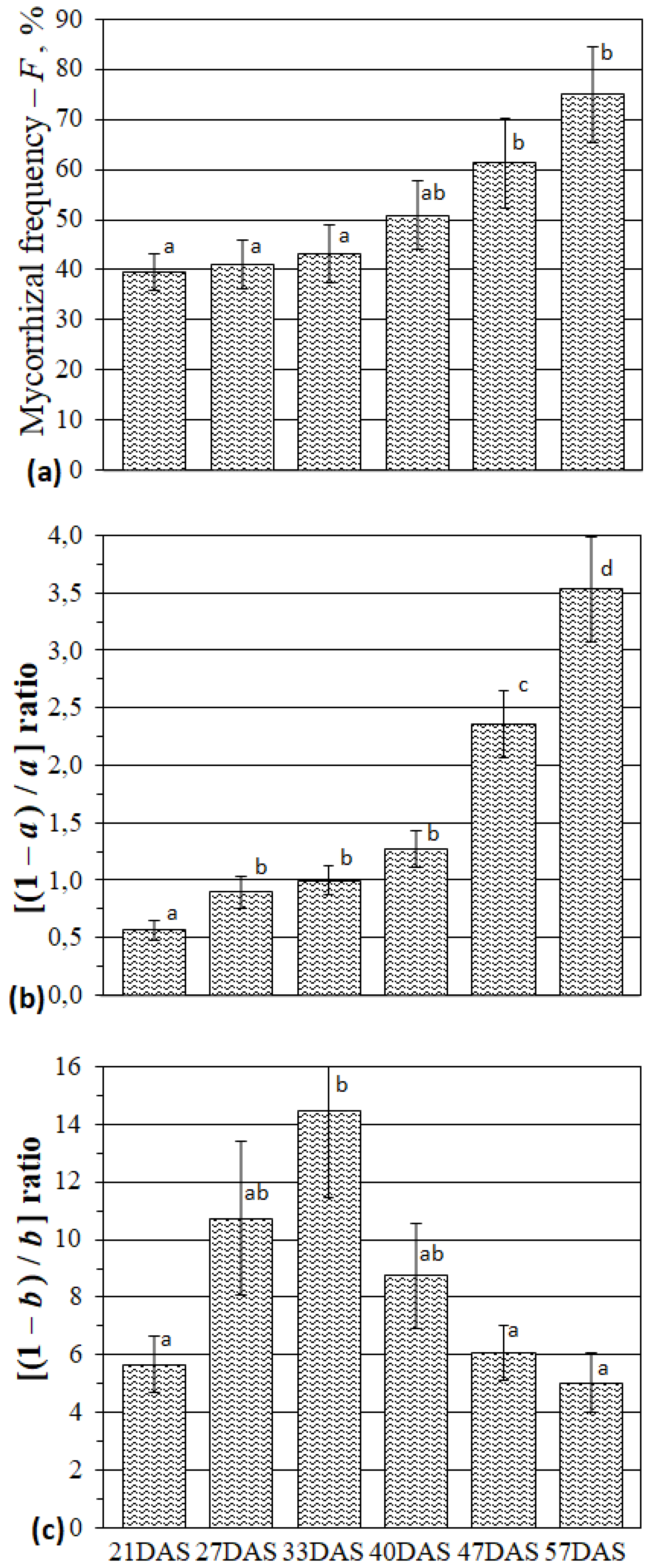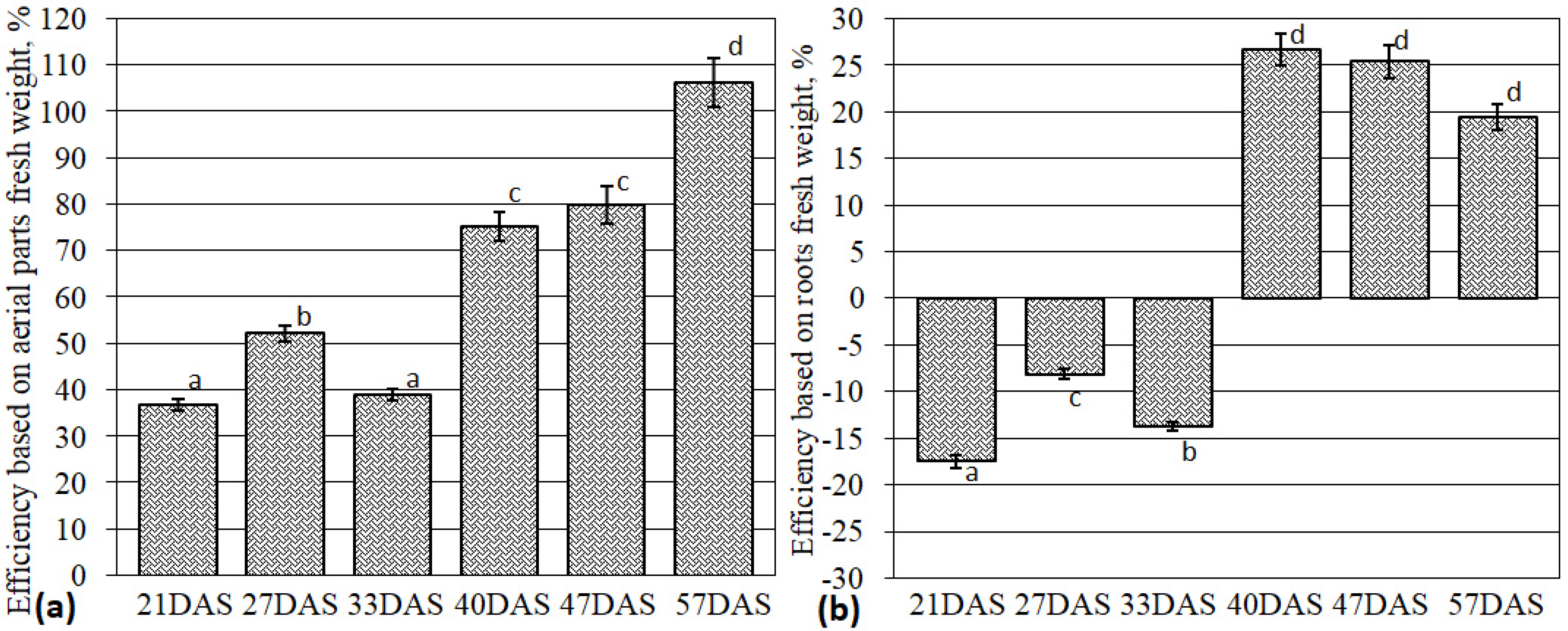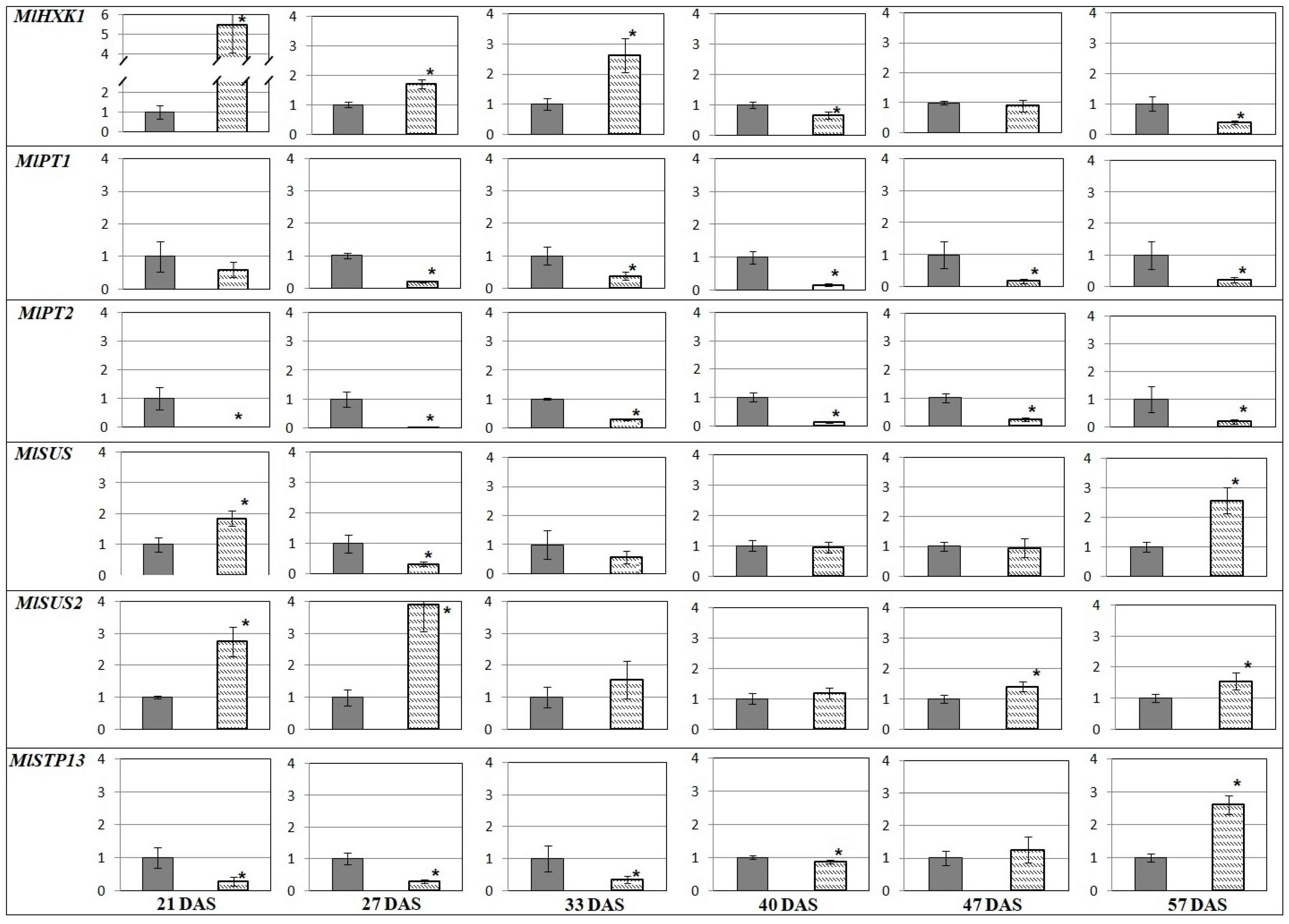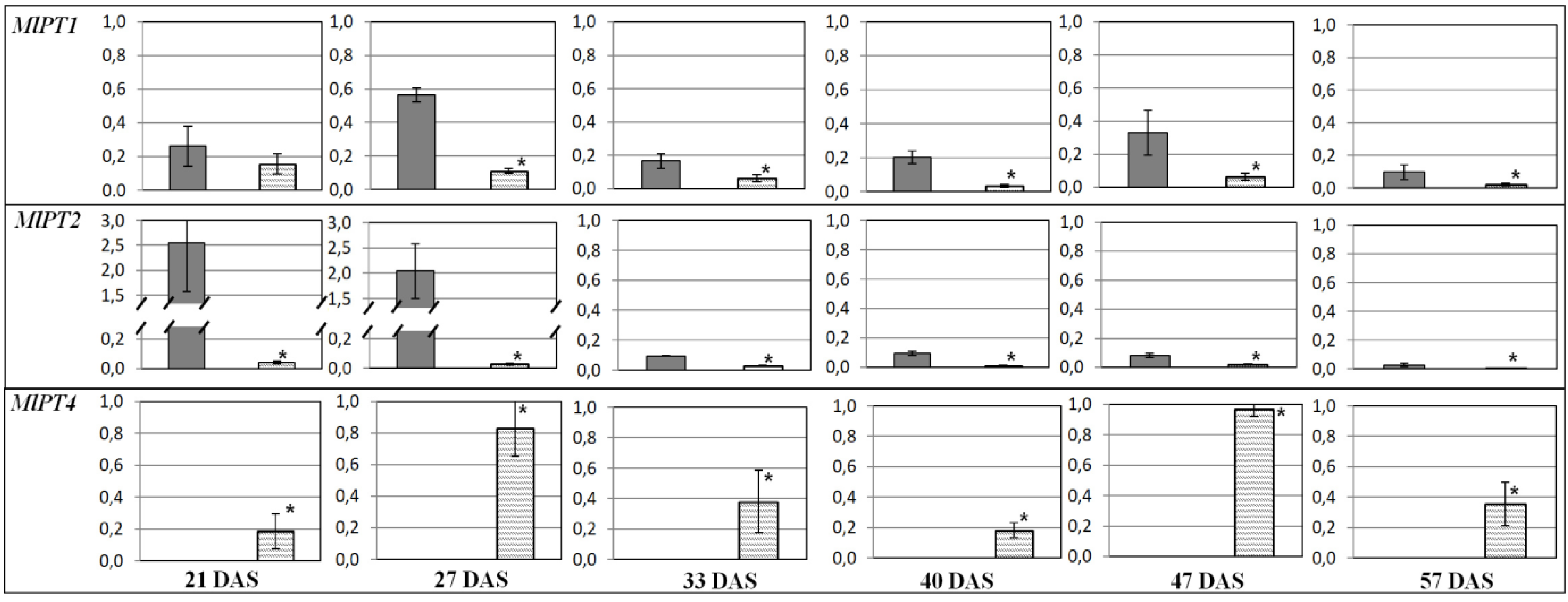AM-Induced Alteration in the Expression of Genes, Encoding Phosphorus Transporters and Enzymes of Carbohydrate Metabolism in Medicago lupulina
Abstract
1. Introduction
1.1. Phosphate Transport in AM Plants
1.2. Carbohydrate Metabolism of AM Plants
2. Results
3. Discussion
4. Conclusions
5. Materials and Methods
5.1. Biomaterials
5.2. Microvegetation Method
5.3. Evaluation of Mycorrhization Parameters
5.4. Evaluation of AM Symbiotic Efficiency
5.5. RNA Isolation and Expression Evaluation for Genes of Interest
5.6. Statistical Analysis
Author Contributions
Funding
Acknowledgments
Conflicts of Interest
References
- Spatafora, J.W.; Chang, Y.; Benny, G.L.; Lazarus, K.; Smith, M.E.; Berbee, M.L.; Bonito, G.; Corradi, N.; Grigoriev, I.; Gryganskyi, A.; et al. A phylum-level phylogenetic classification of zygomycete fungi based on genome-scale data. Mycologia 2017, 108, 1028–1046. [Google Scholar] [CrossRef] [PubMed]
- Delano-Frier, J.P.; Tejeda-Sartorius, M. Unraveling the network: Novel developments in the understanding of signaling and nutrient exchange mechanisms in the arbuscular mycorrhizal symbiosis. Plant Signal. Behav. 2008, 3, 936–944. [Google Scholar] [CrossRef] [PubMed][Green Version]
- Beilby, J.P.; Kidby, D.K. Biochemistry of ungerminated and germinated spores of the vesicular-arbuscular mycorrhizal fungus, Glomus caledonius: Changes in neutral and polar lipids. J. Lipid Res. 1980, 21, 739–750. [Google Scholar] [PubMed]
- Luginbuehl, L.H.; Oldroyd, G.E.D. Understanding the arbuscule at the heart of endomycorrhizal symbioses in plants. Curr. Biol. 2017, 27, R952–R963. [Google Scholar] [CrossRef] [PubMed]
- Smith, S.E.; Read, D.J. Mycorrhizal Symbiosis, 3rd ed.; Academic Press: London, UK, 2008; 787p. [Google Scholar]
- Fitter, A. Costs and benefits of mycorrhizas: Implications for functioning under natural conditions. Experientia 1991, 47, 350–355. [Google Scholar] [CrossRef]
- Li, H.; Smith, F.A.; Dickson, S.; Holloway, R.E.; Smith, S.E. Plant growth depressions in arbuscular mycorrhizal symbioses: Not just caused by carbon drain? New Phytol. 2008, 178, 852–862. [Google Scholar] [CrossRef]
- Schachtman, D.P.; Read, R.J.; Ayling, S.M. Phosphorus uptake by plants: From soil to cell. Plant Physiol. 1998, 116, 447–453. [Google Scholar] [CrossRef]
- Wang, X.X.; Hoffland, E.; Feng, G.; Kuyper, T.W. Phosphate uptake from phytate due to hyphae-mediated phytase activity by arbuscular mycorrhizal maize. Front. Plant Sci. 2017, 8, 684. [Google Scholar] [CrossRef]
- Xie, X.; Huang, W.; Liu, F.; Tang, N.; Liu, Y.; Lin, H.; Zhao, B. Functional analysis of the novel mycorrhiza-specific phosphate transporter AsPT1 and PHT1 family from Astragalus sinicus during the arbuscular mycorrhizal symbiosis. New Phytol. 2013, 198, 836–852. [Google Scholar] [CrossRef]
- Pao, S.S.; Paulsen, I.T.; Saier, M.H., Jr. Major facilitator superfamily. Microbiol. Mol. Biol. Rev. 1998, 62, 1–34. [Google Scholar] [CrossRef]
- Liu, J.; Versaw, W.K.; Pumplin, N.; Gomez, S.K.; Blaylock, L.A.; Harrison, M.J. Closely related members of the Medicago truncatula PHT1 phosphate transporter gene family encode phosphate transporters with distinct biochemical activities. J. Biol. Chem. 2008, 283, 24673–24681. [Google Scholar] [CrossRef] [PubMed]
- Voß, S.; Betz, R.; Heidt, S.; Corradi, N.; Requena, N. RiCRN1, a crinkler effector from the arbuscular mycorrhizal fungus Rhizophagus irregularis, functions in arbuscule development. Front. Microbiol. 2018, 9, 1–18. [Google Scholar] [CrossRef] [PubMed]
- Chiou, T.J.; Liu, H.; Harrison, M.J. The spatial expression patterns of a phosphate transporter (MtPT1) from Medicago truncatula indicate a role in phosphate transport at the root/soil interface. Plant J. 2001, 25, 281–293. [Google Scholar] [CrossRef] [PubMed]
- Grunwald, U.; Guo, W.; Fischer, K.; Isayenkov, S.; Ludwig-Müller, J.; Hause, B.; Yan, X.; Küster, H.; Franken, P. Overlapping expression patterns and differential transcript levels of phosphate transporter genes in arbuscular mycorrhizal, Pi-fertilised and phytohormone-treated Medicago truncatula roots. Planta 2009, 229, 1023–1034. [Google Scholar] [CrossRef]
- Pumplin, N.S. Cell Biology of the Arbuscular Mycorrhizal Symbiosis: Localization and Functional Studies of Medicago truncatula Phosphate Transporters and Vapyrin. Ph.D. Thesis, Cornell University, Ithaca, NY, USA, 20 October 2010. [Google Scholar]
- Floss, D.S.; Levy, J.G.; Lévesque-Tremblay, V.; Pumplin, N.; Harrison, M.J. DELLA proteins regulate arbuscule formation in arbuscular mycorrhizal symbiosis. Proc. Natl. Acad. Sci. USA 2013, 110, E5025–E5034. [Google Scholar] [CrossRef]
- Breuillin-Sessoms, F.; Floss, D.S.; Gomez, S.K.; Pumplin, N.; Ding, Y.; Levesque-Tremblay, V.; Noar, R.D.; Daniels, D.A.; Bravo, A.; Eaglesham, J.B.; et al. Suppression of Arbuscule Degeneration in Medicago truncatula phosphate transporter 4 Mutants is Dependent on the Ammonium Transporter 2 Family Protein AMT2;3. Plant Cell 2015, 27, 1352–1366. [Google Scholar] [CrossRef]
- Krajinski, F.; Hause, B.; Gianinazzi-Pearson, V.; Franken, P. Mtha1, a plasma membrane H+- ATPase gene from Medicago truncatula, shows arbusculespecific induced expression in mycorrhizal tissue. Plant Biol. 2002, 4, 754–761. [Google Scholar] [CrossRef]
- Krajinski, F.; Courty, P.E.; Sieh, D.; Franken, P.; Zhang, H.; Bucher, M.; Gerlach, N.; Kryvoruchko, I.; Zoeller, D.; Udvardi, M.; et al. The H+-ATPase HA1 of Medicago truncatula is essential for phosphate transport and plant growth during arbuscular mycorrhizal symbiosis. Plant Cell 2014, 26, 1808–1817. [Google Scholar] [CrossRef]
- Aung, K.; Lin, S.; Wu, C.; Huang, Y.; Su, C.; Chiou, T. pho2, a phosphate overaccumulator, is caused by a nonsense mutation in a microRNA399 target gene. Plant Physiol. 2006, 141, 1000–1011. [Google Scholar] [CrossRef]
- Bari, R.; Datt Pant, B.; Stitt, M.; Scheible, W.R. PHO2, microRNA399, and PHR1 define a phosphate-signaling pathway in plants. Plant Physiol. 2006, 141, 988–999. [Google Scholar] [CrossRef]
- Chiou, T.J.; Aung, K.; Lin, S.I.; Wu, C.C.; Chiang, S.F.; Su, C.L. Regulation of phosphate homeostasis by microRNA in Arabidopsis. Plant Cell 2006, 18, 412–421. [Google Scholar] [CrossRef] [PubMed]
- Xue, L.; Klinnawee, L.; Zhou, Y.; Saridis, G.; Vijayakumar, V.; Brands, M.; Dörmann, P.; Gigolashvili, T.; Turck, F.; Bucher, M. AP2 transcription factor CBX1 with a specific function in symbiotic exchange of nutrients in mycorrhizal Lotus japonicus. Proc. Natl. Acad. Sci. USA 2018, 115, E9239–E9246. [Google Scholar] [CrossRef] [PubMed]
- Bago, B.; Pfeffer, P.E.; Shachar-Hill, Y. Carbon metabolism and transport in arbuscular mycorrhizas. Plant Physiol. 2000, 124, 949–957. [Google Scholar] [CrossRef]
- Luginbuehl, L.H.; Menard, G.N.; Kurup, S.; van Erp, H.; Radhakrishnan, G.V.; Breakspear, A.; Oldroyd, G.E.D.; Eastmond, P.J. Fatty acids in arbuscular mycorrhizal fungi are synthesized by the host plant. Science 2017, 356, 1175–1178. [Google Scholar] [CrossRef] [PubMed]
- Doidy, J.; Grace, E.; Kühn, C.; Simon-Plas, F.; Casieri, L.; Wipf, D. Sugar transporters in plants and in their interactions with fungi. Trends Plant Sci. 2012, 17, 413–422. [Google Scholar] [CrossRef] [PubMed]
- Doidy, J.; van Tuinen, D.; Lamotte, O.; Corneillat, M.; Alcaraz, G.; Wipf, D. The Medicago truncatula sucrose transporter family: Characterization and implication of key members in carbon partitioning towards arbuscular mycorrhizal fungi. Mol. Plant 2012, 5, 1346–1358. [Google Scholar] [CrossRef] [PubMed]
- Hennion, N.; Durand, M.; Vriet, C.; Doidy, J.; Maurousset, L.; Lemoine, R.; Pourtau, N. Sugars en route to the roots. Transport, metabolism and storage within plant roots and towards microorganisms of the rhizosphere. Physiol. Plant 2019, 165, 44–57. [Google Scholar] [CrossRef]
- Baier, M.C.; Keck, M.; Godde, V.; Niehaus, K.; Kuster, H.; Hohnjec, N. Knockdown of the symbiotic sucrose synthase MtSucS1 affects arbuscule maturation and maintenance in mycorrhizal roots of Medicago truncatula. Plant Physiol. 2010, 152, 1000–1014. [Google Scholar] [CrossRef]
- Fliege, R.; Flugge, U.I.; Werdan, K.; Heldt, H.W. Specific transport of inorganic phosphate, 3-phosphoglycerate and triosephosphates across the inner membrane of the envelope in spinach chloroplasts. Biochim. Biophys. Acta 1978, 502, 232–247. [Google Scholar] [CrossRef]
- Flügge, U.I.; Fischer, K.; Gross, A.; Sebald, W.; Lottspeich, F.; Eckerskorn, C. The triose phosphate-3-phosphoglycerate-phosphate translocator from spinach chloroplasts: Nucleotide sequence of a full-length cDNA clone and import of the in vitro synthesized precursor protein into chloroplasts. EMBO J. 1989, 8, 39–46. [Google Scholar] [CrossRef]
- Yurkov, A.P.; Kryukov, A.A.; Gorbunova, A.O.; Afonin, A.M.; Kirpichnikova, A.A.; Dobryakova, K.S.; Machs, E.M.; Shishova, M.F. Molecular genetic mechanisms of sugar transport in plants in the absence and during arbuscular mycorrhyza development. Ecol. Genet. 2019, 17, 81–99. [Google Scholar] [CrossRef]
- Harrison, M.J. A sugar transporter from Medicago truncatula: Altered expression pattern in roots during vesicular-arbuscular (VA) mycorrhizal associations. Plant J. 1996, 9, 491–503. [Google Scholar] [CrossRef] [PubMed]
- Lefebvre, B.; Furt, F.; Hartmann, M.A.; Michaelson, L.V.; Carde, J.P.; Sargueil-Boiron, F.; Rossignol, M.; Napier, J.A.; Cullimore, J.; Bessoule, J.J.; et al. Characterization of lipid rafts from Medicago truncatula root plasma membranes: A proteomic study reveals the presence of a raft-associated redox system. Plant Physiol. 2007, 144, 402–418. [Google Scholar] [CrossRef] [PubMed]
- Bitterlich, M.; Krügel, U.; Boldt-Burisch, K.; Franken, P.; Kühn, C. The sucrose transporter SlSUT2 from tomato interacts with brassinosteroid functioning and affects arbuscular mycorrhiza formation. Plant J. 2014, 78, 877–889. [Google Scholar] [CrossRef] [PubMed]
- Gabriel-Neumann, E.; Neumann, G.; Leggewie, G.; George, E. Constitutive overexpression of the sucrose transporter SoSUT1 in potato plants increases arbuscular mycorrhiza fungal root colonization under high, but not under low, soil phosphorus availability. J. Plant Physiol. 2011, 168, 911–919. [Google Scholar] [CrossRef] [PubMed]
- Manck-Gotzenberger, J.; Requena, N. Arbuscular mycorrhiza symbiosis induces a major transcriptional reprogramming of the potato SWEET sugar transporter family. Front. Plant Sci. 2016, 7, 487. [Google Scholar] [CrossRef] [PubMed]
- Sugiyama, A.; Saida, Y.; Yoshimizu, M.; Takanashi, K.; Sosso, D.; Frommer, W.B.; Yazaki, K. Molecular characterization of LjSWEET3, a sugar transporter in nodules of Lotus japonicus. Plant Cell Physiol. 2016, 58, 298–306. [Google Scholar] [CrossRef]
- Duensing, N. Transport Processes in the Arbuscular Mycorrhizal Symbiosis. Ph.D. Thesis, University of Potsdam, Potsdam, Germany, 24 October 2013. [Google Scholar]
- Yurkov, A.P.; Veselova, S.V.; Jacobi, L.M.; Stepanova, G.V.; Yemelyanov, V.V.; Kudoyarova, G.R.; Shishova, M.F. The effect of inoculation with arbuscular mycorrhizal fungus Rhizophagus irregularis on cytokinin content in highly mycotrophic Medicago lupulina line under low phosphorus level in soil. Plant Soil Environ. 2017, 63, 519–524. [Google Scholar] [CrossRef]
- Janeeshma, E.; Mirshad, P.P.; Puthur, J.T. Dynamics of Arbuscular Mycorrhizal Development in Relation to Various Growth Stages of Zea mays L. 28th Kerala Science Congress (Jan 2016) Extended Abstracts; University of Calicut: Thenhipalam, Malappuram, 2016; pp. 1975–1979. [Google Scholar]
- Ryan, M.H.; McCully, M.E.; Huang, C.X. Location and quantification of phosphorus and other elements in fully hydrated, soil-grown arbuscular mycorrhizas: A cryo-analytical scanning electron microscopy study. New Phytol. 2003, 160, 429–441. [Google Scholar] [CrossRef]
- Helber, N.; Wippel, K.; Sauer, N.; Schaarschmidt, S.; Hause, B.; Requena, N. A versatile monosaccharide transporter that operates in the arbuscular mycorrhizal fungus Glomus sp is crucial for the symbiotic relationship with plants. Plant Cell 2011, 23, 3812–3823. [Google Scholar] [CrossRef]
- Dickson, S. The Arum-Paris continuum of mycorrhizal symbioses. New Phytol. 2004, 163, 187–200. [Google Scholar] [CrossRef]
- Solaiman, M.Z.; Saito, M. Use of sugars by intraradical hyphae of arbuscular mycorrhizal fungi revealed by radiorespirometry. New Phytol. 1997, 136, 533–538. [Google Scholar] [CrossRef]
- Suzuki, Y.; Makino, A. Availability of rubisco small subunit up-regulates the transcript levels of large subunit for stoichiometric assembly of its holoenzyme in rice. Plant Physiol. 2012, 160, 533–540. [Google Scholar] [CrossRef] [PubMed]
- Yurkov, A.P.; Kryukov, A.A.; Gorbunova, A.O.; Jacobi, L.M.; Vorobiev, N.I.; Shishova, M.F. The Effect of Arbuscular Mycorrhizal Fungus Rhizophagus irregularis on the Development of Black Medick under Phosphorus Deficiency conditions. In Proceedings of the Annual Meeting Society of Plant Physiologists of Russia, Irkutsk, Russia, 10–15 July 2018; I, pp. 840–843. [Google Scholar] [CrossRef]
- Granot, D.; David-Schwartz, R.; Kelly, G. Hexose kinases and their role in sugar-sensing and plant development. Front. Plant Sci. 2013, 4, 44. [Google Scholar] [CrossRef] [PubMed]
- Moore, B.; Zhou, L.; Rolland, F.; Hall, Q.; Cheng, W.H.; Liu, Y.X.; Hwang, I.; Jones, T.; Sheen, J. Role of the Arabidopsis glucose sensor HXK1 in nutrient, light, and hormonal signaling. Science 2003, 300, 332–336. [Google Scholar] [CrossRef] [PubMed]
- Van Dingenen, J.; Antoniou, C.; Filippou, P.; Pollier, J.; Gonzalez, N.; Dhondt, S.; Goossens, A.; Fotopoulos, V.; Inzé, D. Strobilurins as growth-promoting compounds: How stroby regulates Arabidopsis leaf growth. Plant Cell Environ. 2017, 40, 1748–1760. [Google Scholar] [CrossRef]
- Hans, J.; Hause, B.; Strack, D.; Walter, M.H. Cloning, characterization, and immunolocalization of a mycorrhizainducible 1-Deoxy-D-Xylulose 5-Phosphate reductoisomerase in arbuscule-containing cells of maize. Plant Physiol. 2004, 134, 614–624. [Google Scholar] [CrossRef]
- Genre, A.; Bonfante, P. Building a mycorrhizal cell: How to reach compatibility between plants and arbuscular mycorrhizal fungi. J. Plant Interact. 2005, 1, 3–13. [Google Scholar] [CrossRef]
- Bonfante-Fasolo, P. Some ultrastructural features of the vesicular-arbuscular mycorrhiza in the grapevine. Vitis 1978, 17, 386–395. [Google Scholar]
- Fester, T.; Strack, D.; Hause, B. Reorganization of tobacco root plastids during arbuscule development. Planta 2001, 213, 864–868. [Google Scholar] [CrossRef]
- Gutjahr, C.; Novero, M.; Guether, M.; Montanari, O.; Udvardi, M.; Bonfante, P. Presymbiotic factors released by the arbuscular mycorrhizal fungus Gigaspora margarita induce starch accumulation in Lotus japonicus roots. New Phytol. 2009, 183, 53–61. [Google Scholar] [CrossRef] [PubMed]
- Hohnjec, N.; Perlick, A.M.; Puhler, A.; Kuster, H. The Medicago truncatula sucrose synthase gene MtSucS1 is activated both in the infected region of root nodules and in the cortex of roots colonized by arbuscular mycorrhizal fungi. Mol. Plant-Microbe Interact. 2003, 16, 903–915. [Google Scholar] [CrossRef] [PubMed]
- Xiao, X.; Tang, C.; Fang, Y.; Yang, M.; Zhou, B.; Qi, J.; Zhang, Y. Structure and expression profile of the sucrose synthase gene family in the rubber tree: Indicative of roles in stress response and sucrose utilization in the laticifers. FEBS J. 2013, 281, 291–305. [Google Scholar] [CrossRef] [PubMed]
- Wang, W.; Shi, J.; Xie, Q.; Jiang, Y.; Yu, N.; Wang, E. Nutrient exchange and regulation in arbuscular mycorrhizal symbiosis. Mol. Plant 2017, 10, 1147–1158. [Google Scholar] [CrossRef]
- Reinders, A.; Sivitz, A.B.; Starker, C.G.; Gantt, J.S.; Ward, J.M. Functional analysis of LjSUT4, a vacuolar sucrose transporter from Lotus japonicas. Plant Mol. Biol. 2008, 68, 289–299. [Google Scholar] [CrossRef]
- Milne, R.J.; Grof, C.P.; Patrick, J.W. Mechanisms of phloem unloading: Shaped by cellular pathways, their conductances and sink function. Curr. Opin. Plant Biol. 2018, 43, 8–15. [Google Scholar] [CrossRef]
- Pumplin, N.; Harrison, M.J. Live-cell imaging reveals periarbuscular membrane domains and organelle location in Medicago truncatula roots during arbuscular mycorrhizal symbiosis. Plant Physiol. 2009, 151, 809–819. [Google Scholar] [CrossRef]
- Harrison, M.J.; Dewbre, G.R.; Liu, J. A phosphate transporter from Medicago truncatula involved in the acquisition of phosphate released by arbuscular mycorrhizal fungi. Plant Cell 2002, 14, 2413–2429. [Google Scholar] [CrossRef]
- Rausch, C.; Daram, P.; Brunner, S.; Jansa, J.; Laloi, M.; Leggewie, G.; Amrhein, N.; Bucher, M. A phosphate transporter expressed in arbuscule-containing cells in potato. Nature 2001, 414, 462–470. [Google Scholar] [CrossRef]
- Paszkowski, U.; Kroken, S.; Roux, C.; Briggs, S.P. Rice phosphate transporters include an evolutionarily divergent gene specifically activated in arbuscular mycorrhizal symbiosis. Proc. Natl. Acad. Sci. USA 2002, 99, 13324–13329. [Google Scholar] [CrossRef]
- Ferrol, N.; Azcón-Aguilar, C.; Pérez-Tienda, J. Review: Arbuscular mycorrhizas as key players in sustainable plant phosphorus acquisition: An overview on the mechanisms involved. Plant Sci. 2019, 280, 441–447. [Google Scholar] [CrossRef] [PubMed]
- Gianinazzi-Pearson, V.; Arnould, C.; Oufattole, M.; Arango, M.; Gianinazzi, S. Differential activation of H+-ATPase genes by an arbuscular mycorrhizal fungus in root cells of transgenic tobacco. Planta 2000, 211, 609–613. [Google Scholar] [CrossRef] [PubMed]
- Ferrol, N.; Pozo, M.J.; Antelo, M.; Azcón-Aguilar, C. Arbuscular mycorrhizal symbiosis regulates plasma membrane H+-ATPase gene expression in tomato plants. J. Exp. Bot. 2002, 53, 1683–1687. [Google Scholar] [CrossRef] [PubMed]
- Liu, H.; Trieu, A.T.; Blaylock, L.A.; Harrison, M.J. Cloning and characterization of two phosphate transporters from Medicago truncatula roots: Regulation in response to phosphate and to colonization by arbuscular mycorrhizal (AM) fungi. Mol. Plant-Microbe Interact. 1998, 11, 14–22. [Google Scholar] [CrossRef] [PubMed]
- Yurkov, A.P.; Jacobi, L.M.; Gapeeva, N.E.; Stepanova, G.V.; Shishova, M.F. Development of arbuscular mycorrhiza in highly responsive in the mycotrophic host plant—Black medick (Medicago lupulina L.). Russ. J. Dev. Biol. 2015, 46, 263–275. [Google Scholar] [CrossRef]
- Kryukov, A.A.; Yurkov, A.P. Optimization procedures for molecular-genetic identification of arbuscular mycorrhizal fungi in symbiotic phase on the example of two closely kindred strains. Mycol. Phytopathol. (Mikologiya i fitopatologiya) 2018, 52, 38–48. [Google Scholar]
- Yurkov, A.P.; Shishova, M.F.; Semenov, D.G. Features of Development of Black Medic with Endomycorrhizal Fungus; LAMBERT Acad. Publ.: Saarbrücken, Germany, 2010; pp. 54–56. [Google Scholar]
- Yurkov, A.P.; Veselova, S.V.; Jacobi, L.M.; Stepanova, G.V.; Kudoyarova, G.R.; Shishova, M.F. The effect of inoculation with arbuscular mycorrhizal fungus Rhizophagus irregularis on auxin content in highly mycotrophic black medick under low phosphorus level in soil. Sel’skokhozyaistvennaya Biologiya [Agric. Biol.] 2017, 52, 830–838. [Google Scholar] [CrossRef]
- Phillips, J.M.; Hayman, D.S. Improved procedures for clearing roots and staining parasitic and vesicular-arbuscular mycorrhizal fungi for rapid assessment of infection. Trans. Br. Mycol. Soc. 1970, 55, 158–161. [Google Scholar] [CrossRef]
- Trouvelot, A.; Kough, J.L.; Gianinazzi-Pearson, V. Mesure du Taux de Mycorhization VA d’un Système Radiculaire. Recherche de Méthodes Ayant une Signification Fonctionnelle. In Physiological and Genetical Aspects of Mycorrhizae; Gianinazzi-Pearson, V., Gianinazzi, S., Eds.; INRA-Press: Paris, France, 1986; pp. 217–221. [Google Scholar]
- MacRae, E. Extraction of plant RNA. Methods Mol. Biol. 2007, 353, 15–24. [Google Scholar] [CrossRef]
- Gaude, N.; Bortfeld, S.; Duensing, N.; Lohse, M.; Krajinski, F. Arbuscule-containing and non-colonized cortical cells of mycorrhizal roots undergo extensive and specific reprogramming during arbuscular mycorrhizal development. Plant J. 2012, 69, 510–528. [Google Scholar] [CrossRef]
- Wu, J.; Zhang, H.; Liu, L.; Li, W.; Wei, Y.; Shi, S. Validation of reference genes for RT-qPCR studies of gene expression in preharvest and postharvest longan fruits under different experimental conditions. Front. Plant Sci. 2016, 3, 780. [Google Scholar] [CrossRef] [PubMed]
- Zhang, M.F.; Liu, Q.; Jia, G.X. Reference gene selection for gene expression studies in lily using quantitative real-time PCR. Genet. Mol. Res. 2016, 15. [Google Scholar] [CrossRef] [PubMed]





| Analysis No | Day after Sowing and Inoculation (DAS) | Host Plant Development Stage | |
|---|---|---|---|
| without AM | +AM | ||
| 1 | 21 | 2nd leaf initiation (2LI) | 2nd leaf development (2L) |
| 2 | 27 | 2nd leaf development (2L) | shooting initiation, 3rd leaf (3L) |
| 3 | 33 | shooting initiation, 3rd leaf (3L) | 4th leaf, shooting (SH) |
| 4 | 40 | 4th leaf, shooting (SH) | 5th leaf development, axillary shoot branching initiation (SBI) |
| 5 | 47 | 5th leaf development, axillary shoot branching initiation (SBI) | 6–7th leaf development, axillary shoot branching (SB) |
| 6 | 57 | 6–7th leaf development, axillary shoot branching, flowering initiation (FI) | 8th leaf, flowering initiation (FI) |
| Gene Names | Names of the Primers | Primer Sequences | Gene Bank Sequense Numbers |
|---|---|---|---|
| MlHXK1 | HXK1-1F | CCCTGGAGAACAGATTTTTGAGA | MN737455 |
| HXK1-1R | CCTCAATTTGCTTCCAACCTC | ||
| MlPT1 | PT1-2F | TACTCACTCACATTCTTCTTTGC | MN737457 |
| PT1-2R | CCAAGCATGATAAGAGAGTTCTTA | ||
| MlPT2 | PT2-2F | CAGAACAAGGACAAGAGTAAAGC | MN737458 |
| PT2-2R | CCGTTTTGTTATGAGAATGAGATTG | ||
| MlPT4 | PT4-1F | GGGATTAGAAGTCCTTGAGGC | MN737459 |
| PT4-1R | GGCCACACCGGTGACTAAG | ||
| MlSUS | SUS-3F | GGAGAGGCTTGATGAAACCTT | MN756680 |
| SUS-3R | CCAAATGCACCATCAGTCAG | ||
| MlSUS2 | SUS2-2F | GATACTCTTTCTGCTCACCGTA | MN737460 |
| SUS2-2R | GACATTAACACGGACATATTCCC | ||
| MlSUC4 | SUC4-2F | GGAGCTATTTGGGACATTCAG | MN737461 |
| SUC4-2R | CTGAATTAAGCAATAAACCAAGTGC | ||
| MlRUB | RUB-1F | GGCTTCCTCTATGATCTCCTC | MN737462 |
| RUB-1R | GCCAATAGGAGGCCACACC | ||
| MlATP1 | ATP1-2F | CCTTTGTCATGGGTTATGGAAG | MN737456 |
| ATP1-2R | CATTTTCCGTCGCGAAGTACC | ||
| MlSTP13 | STP13-2F | GTTTGTGTCAACTTCCTCTTCAC | MN737463 |
| STP13-2R | CAATGTTGCTTCCACACTCTTTG | ||
| MlActin | actin7-f2 | GGCAGATGCTGAGGATATTCAA | MN756679 |
| actin7-r2 | GTATGACGAGGTCGGCCAA |
© 2020 by the authors. Licensee MDPI, Basel, Switzerland. This article is an open access article distributed under the terms and conditions of the Creative Commons Attribution (CC BY) license (http://creativecommons.org/licenses/by/4.0/).
Share and Cite
Yurkov, A.; Kryukov, A.; Gorbunova, A.; Sherbakov, A.; Dobryakova, K.; Mikhaylova, Y.; Afonin, A.; Shishova, M. AM-Induced Alteration in the Expression of Genes, Encoding Phosphorus Transporters and Enzymes of Carbohydrate Metabolism in Medicago lupulina. Plants 2020, 9, 486. https://doi.org/10.3390/plants9040486
Yurkov A, Kryukov A, Gorbunova A, Sherbakov A, Dobryakova K, Mikhaylova Y, Afonin A, Shishova M. AM-Induced Alteration in the Expression of Genes, Encoding Phosphorus Transporters and Enzymes of Carbohydrate Metabolism in Medicago lupulina. Plants. 2020; 9(4):486. https://doi.org/10.3390/plants9040486
Chicago/Turabian StyleYurkov, Andrey, Alexey Kryukov, Anastasia Gorbunova, Andrey Sherbakov, Ksenia Dobryakova, Yulia Mikhaylova, Alexey Afonin, and Maria Shishova. 2020. "AM-Induced Alteration in the Expression of Genes, Encoding Phosphorus Transporters and Enzymes of Carbohydrate Metabolism in Medicago lupulina" Plants 9, no. 4: 486. https://doi.org/10.3390/plants9040486
APA StyleYurkov, A., Kryukov, A., Gorbunova, A., Sherbakov, A., Dobryakova, K., Mikhaylova, Y., Afonin, A., & Shishova, M. (2020). AM-Induced Alteration in the Expression of Genes, Encoding Phosphorus Transporters and Enzymes of Carbohydrate Metabolism in Medicago lupulina. Plants, 9(4), 486. https://doi.org/10.3390/plants9040486





